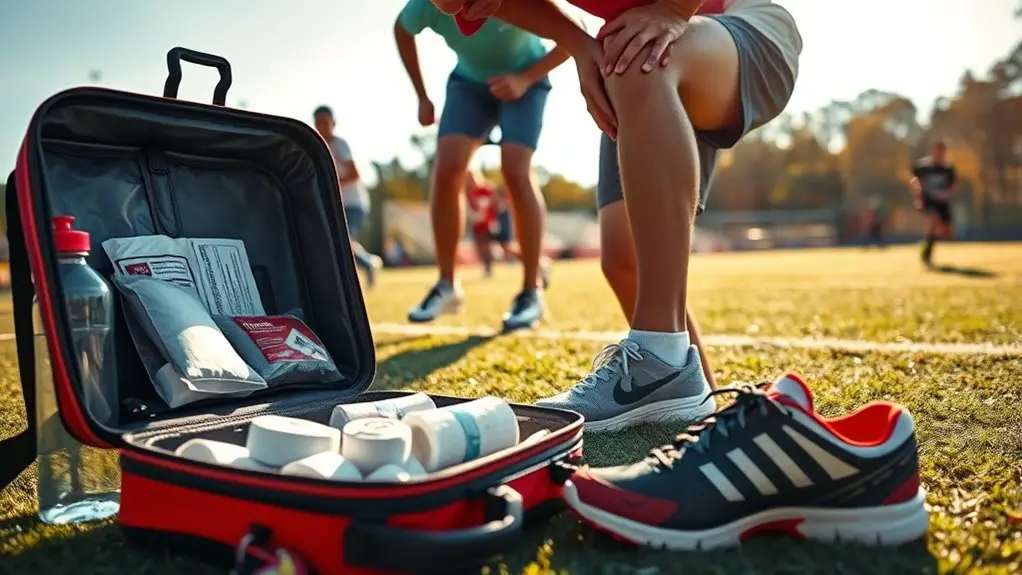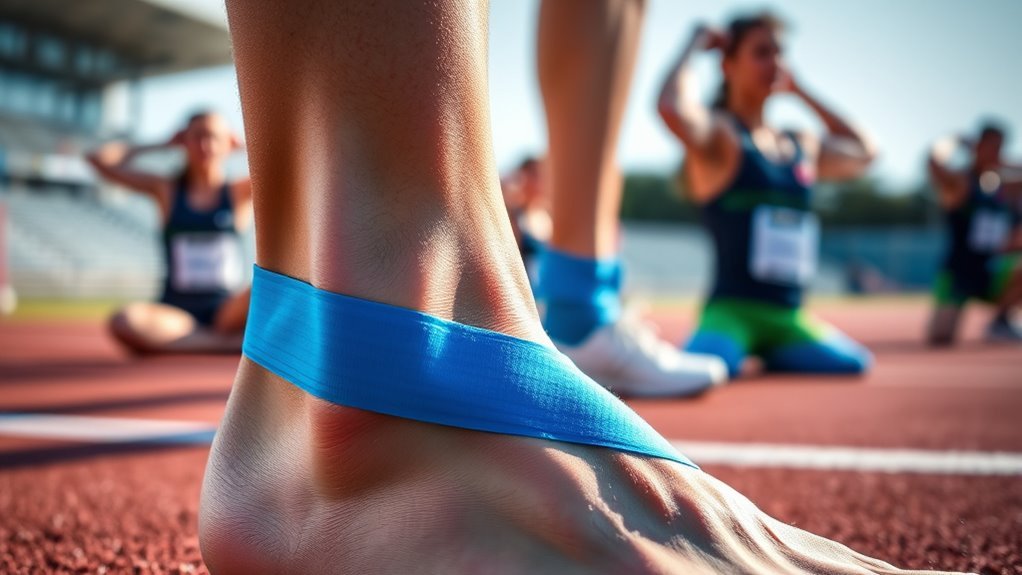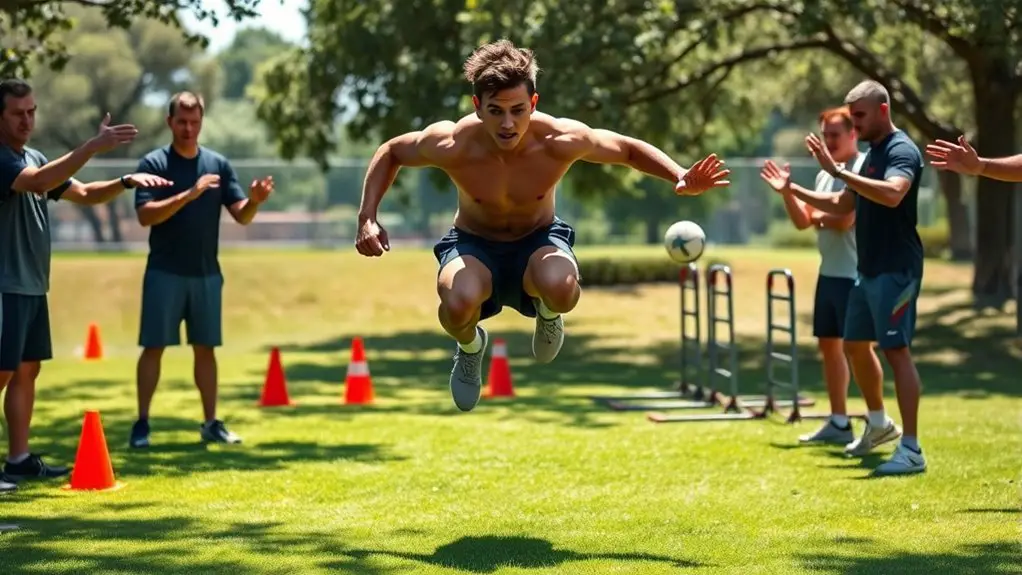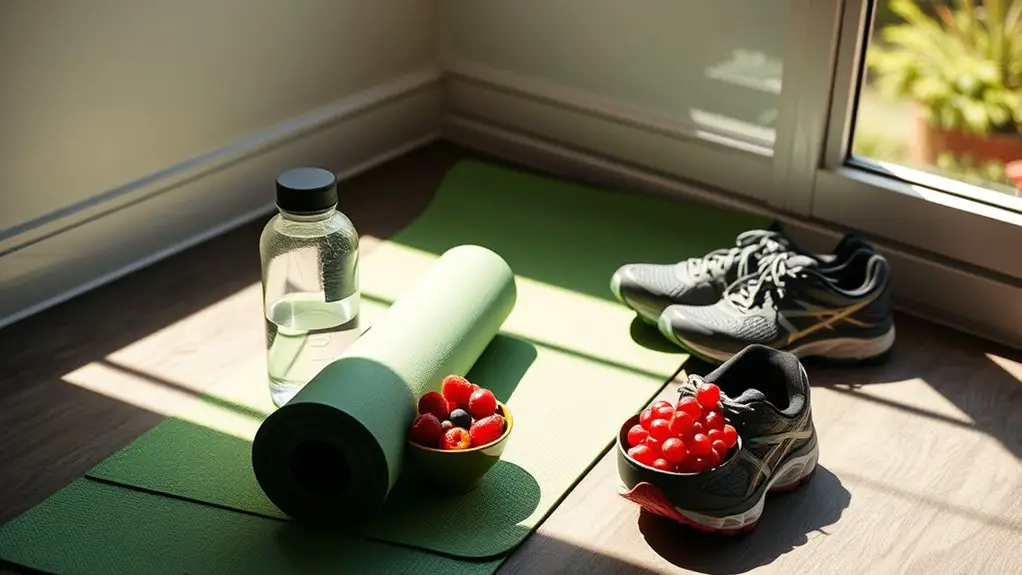Common sports injuries include sprains, strains, fractures, tendonitis, runner's knee, and shin splints. To prevent them, always warm up properly, listen to your body, and use the right gear. Gradually increase your activity levels and focus on strengthening exercises. Stretching is key too, especially for tight muscles. Staying informed about injury prevention can help you enjoy your favorite sports more safely. There's much more to learn about keeping yourself injury-free in your athletic pursuits!
Sprains and Strains
Sprains and strains are among the most common injuries athletes face, often resulting from overexertion or improper technique. When you push your body too hard or don't warm up properly, you risk damaging ligaments or muscles. A sprain typically involves a ligament, while a strain affects a muscle or tendon. Both can sideline you when you're chasing that freedom to move and play. To stay in the game, focus on proper warm-ups, stretch, and listen to your body. If you feel pain or discomfort, don't brush it off; give yourself time to heal. Remember, taking care of yourself is key to enjoying your favorite sports without the nagging worry of injury. Embrace your passion, but prioritize your well-being!
Fractures
While engaging in sports can be exhilarating, the risk of fractures can turn that excitement into a serious setback. Fractures can occur from falls, collisions, or overuse, often leading to time away from your favorite activities. To keep your freedom intact and minimize the risk of fractures, consider these preventive measures:
- Warm up properly: Always take time to stretch and warm up your muscles before diving into intense activity.
- Use appropriate gear: Wear protective equipment, like helmets and pads, tailored to your specific sport to cushion potential impacts.
- Strengthen your bones: Engage in weight-bearing exercises and make sure you're getting enough calcium and vitamin D for peak bone health.
Tendonitis
Tendonitis can feel like a nagging reminder that even the most enjoyable activities come with their share of risks. This overuse injury often strikes when you push your limits without adequate rest. To keep enjoying your favorite sports without the pain, consider these prevention tips:
| Prevention Tips | Description |
|---|---|
| Warm Up | Always start with dynamic stretches. |
| Strength Training | Build muscle around affected tendons. |
| Listen to Your Body | Don't ignore pain; rest if needed. |
| Gradual Progression | Increase intensity slowly. |
| Proper Technique | Confirm your form is correct in all activities. |
Runner's Knee
Runner's knee, also known as patellofemoral pain syndrome, affects about 25% of all runners at some point in their training. This condition can cause pain around your kneecap, making it tough to enjoy your runs. To help prevent runner's knee, consider these tips:
Runner's knee impacts 25% of runners, causing kneecap pain that can hinder your training.
- Strengthen your legs: Focus on exercises that build your quadriceps, hamstrings, and calves.
- Choose the right shoes: Invest in well-fitted running shoes that offer proper support and cushioning.
- Gradually increase mileage: Avoid sudden jumps in your running distance to give your body time to adapt.
Shin Splints
Shin splints, affecting nearly 40% of runners, can be a frustrating setback in your training. They often arise from overuse, improper footwear, or running on hard surfaces. You might feel pain along the inner part of your lower leg, which can limit your freedom to run and enjoy your workouts. To prevent shin splints, consider gradually increasing your mileage and incorporating rest days into your routine. Make sure you're wearing shoes that provide adequate support and cushioning. Stretching and strengthening exercises for your calves and shins can also help. Listen to your body; if you feel pain, don't push through it. Instead, take the time to heal so you can get back to the activities you love without restrictions.
Ankle Injuries
Ankle injuries are among the most common complaints in sports, affecting athletes of all levels. Whether you're running, jumping, or playing a team sport, it's easy to twist or strain an ankle. To keep your ankles strong and injury-free, try these tips:
- Warm Up Properly: Always start with dynamic stretches to prepare your muscles and joints.
- Wear Supportive Footwear: Choose shoes that provide good arch support and cushioning tailored for your activity.
- Strengthen Your Ankles: Incorporate balance exercises and resistance training to build stability and flexibility.
Concussions
Concussions are a serious concern in sports, often resulting from impacts to the head during play. To keep yourself safe, it's crucial to recognize the signs and understand prevention strategies. Here's a breakdown of symptoms and tips:
| Symptoms | Prevention | What to Do |
|---|---|---|
| Headache | Wear proper gear | Seek medical help |
| Dizziness | Practice safe techniques | Monitor recovery |
| Confusion | Follow rules | Avoid further play |
| Nausea | Strengthen neck muscles | Rest appropriately |
| Sensitivity to light | Stay hydrated | Keep a calm environment |
Stress Fractures
Injuries in sports can take many forms, and while concussions are often in the spotlight, stress fractures are equally concerning. These tiny cracks in your bones can develop from overuse, especially if you're pushing your limits without proper care. To avoid stress fractures, keep these tips in mind:
- Balance Training: Mix high-impact activities with low-impact exercises to reduce strain on your bones.
- Proper Footwear: Invest in well-fitted shoes that provide adequate support for your specific sport.
- Listen to Your Body: If you feel persistent pain, don't ignore it. Rest and recover to prevent further injury.
Frequently Asked Questions
What Are the Signs of a Serious Sports Injury?
If you're experiencing severe pain, swelling, or inability to move a joint, it could indicate a serious injury. Numbness, unusual bruising, or a popping sound during an incident can also signal something's seriously wrong.
How Can I Safely Return to Sports After an Injury?
To safely return to sports after an injury, take it slow. Listen to your body, gradually increase activity, and consult a professional if needed. Stay positive; your strength and passion will guide you back!
Are Certain Sports More Prone to Specific Injuries?
Yeah, some sports definitely have higher injury risks. For instance, contact sports often lead to concussions, while running can cause knee issues. Knowing your sport's risks helps you stay proactive and enjoy your activities safely.
When Should I Seek Professional Help for an Injury?
You might think ignoring pain's a ticket to freedom, but if you can't walk, bend, or enjoy life, it's time to seek professional help. Your body deserves attention, not just your stubbornness. Don't wait too long!
What Role Does Nutrition Play in Injury Prevention?
Nutrition's essential for keeping your body strong and resilient. It fuels your workouts, aids recovery, and supports your immune system. Eating well helps you stay active and reduces the risk of injuries during your adventures.




